- Home
- Instruments
- Gear
- Recording
- Lessons
- Reviews
- Blog
So I reached into my mailbag of questions and pulled out a question that had nothing to do with guitar. The next one was inappropriate. The one after that was easily answered, 42 (your welcome Josh from Tempe, Arizona). Then came this question: How can I make a chord progression more interesting?
It seems easy to answer this question at first glance, but then all the possibilities that exist within music start to make an appearance. This is quite a complicated question.
Let’s make some assumptions. There will be one chord progression through our entire song. I’m also assuming you’re talking about writing your own chord progressions, although some of these ideas could be applied to cover songs to make them more your own interpretation.
Let’s start off with this simple chord progression.
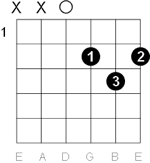
D
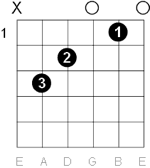
C
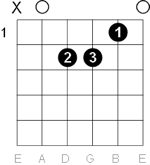
Am
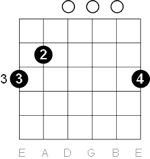
G
Pull out your guitar and play it.
One thing you might want to try first is adding some spice to the progression by adding some suspensions or 7ths to the chords. Like changing the Am to Am7. You can do this simply by lifting your third finger off the second fret in the diagram above. You’ll notice it is now very similar to the C chord that came before it.
Add a sus4 to the D chord (fret the third fret on the first sting to add the sus4), which is a nice transition from the G chord then a nice lead into the C chord. Figure out where each of these chords has a sus4 and try adding it to the chord progression. Listen for the ones that lead into the next chord the best.
Swap out Chords
Try different chords and see how you like the way they sound. Swap out the D for a Dm chord. Then remove the C and replace it with an F. Your chord progression will sound very different and look like this now:
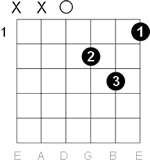
Dm
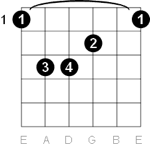
F
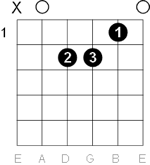
Am
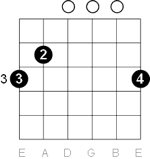
G
Try swapping any and all of the chords. Challenge yourself by trying chord forms you’ve never used before, which leads me to my next suggestion…
Different Voicings
A simple way to make the progression sound different is playing the chords in different positions. If you play in a large group this is also a good way to find a place to live within the mix. If you play with a guy who plays open chords, then you don’t want to be playing the same chord voicings. Learn all the different places you can play a chord all along the neck. It’ll open up your choices, and give you more interesting things to try.
In our original chord progression we can do the bar chords:
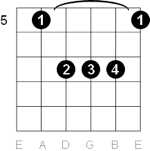
D
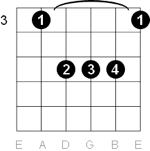
C
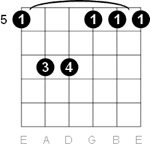
Am
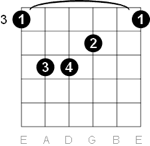
G
Then pull in the suspensions and sevenths from the earlier example and you get another interesting take on the same progression, which looks like this now:
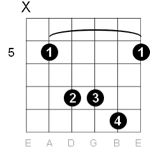
Dsus4
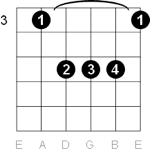
C
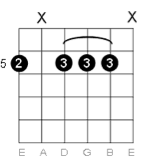
Am7
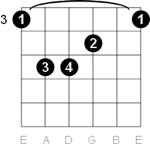
Notice on the C-Am7 the D, G, and B strings are all fretted on the 5th fret just the bass note changes (along with the strings you don’t play).
If you are an electric player and you are in a band with an acoustic guitar player and a keyboardist you might want to move even farther up the neck to create some separation from those other instruments. Like this:
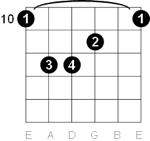
D
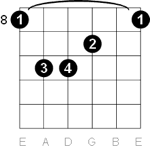
C
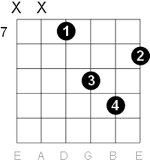
Am
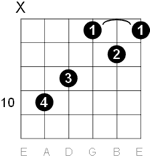
G
You don’t even need to fret all of those notes, if you just do the highest three or four stings you will be getting all the components of each chord.
The Way You Play
There are so many ways to pull the notes out the guitar try using that to your advantage. Palm muting can add a different color to your sound palette. This can either add an aggressive nature to the progression or pull the guitar down in the mix with a very staccato sound.
Arpeggios are another way of adding to the progression. Let each note of the chord have a moment to be heard. Throw in those suspended notes to add even more color. These are just two examples of countless others that you could try.
Dynamics
Music just doesn’t live in the notes we play, but in how we play them. If you play a chord progression real hard then pull back and play it softly you’ve created a different vibe for each progression.
I try to listen to the singer, and wait for space to play a little louder. You don’t want to be stepping on the singer’s performance, since the part they are singing is the main focus of the song at that moment. You need to find the space in between to shine.
Rhythm
Changing up the rhythm will give the progression a different feel. Do some big lush open chords where you hold each for the full count of the measure, or chug away with quarter notes whether open or palm muted. Each way of playing makes the progression have a different feel. Then do different strumming patterns for each chord. Slow it down or speed it up. Again, there are so many possibilities.
Different Count
Most likely you played the progression with the same number of beats per chord. Try changing it up. Do a three count on the D then a one count on C, then a three count on Am then a one count on the G. This gives the progression a different feel, and will probably change your strumming pattern. Try playing on the upbeat and ignore the down beat will give it a reggae feel. The possibilities are endless if you just try stepping outside the four count box.
Trying different time signatures will also give the progression some new life. The waltz feel of 3/4 or the odd numbering of 7/8.
Different Tones
This is all dependent on your style and the type of gear you have. If you like to play with your volume knob on the guitar, then try pulling back the volume during the verse then cranking it back up for the chorus or during the build of a bridge.
Change the pickup you’re on (if you have that option). A neck pickup is going to give you a different tone than the bridge pickup.
Try different effects for each section of the song. It might be too much to change for each chord, but if that sounds good to you then go ahead. Use an effect you’ve never used before and see how it effects the way you play the progression. Use technology to your advantage.
Delays are a fun way to create a different rhythmic pattern, sometimes machine like in its accuracy. The Edge from U2 is the perfect example. Not only will you get a new sound, but it will help you keep a very accurate tempo (those repeats on the delay act like a drummer or drum machine).
Arrangement
Try not playing, granted this only works when there are other musicians to play off of. Let the bass player carry the progression. Find the space in the song. Depending on how many players are in your band this works differently. A power trio where one instrument goes tacit is very striking, while in a larger group it might be hardly noticed.
I wrote a song years ago where the guitar played on the one then was quiet for the rest of the measure. On the rest of the measure the bass played a melodic line. This repeated on the second measure. The third measure the bass was tacit leaving only the drums. Then finally on the fourth measure the guitar and bass played together. It created a bit of interest going through the chord progression, which by the way only had two chords.
Give the other instruments space to find their voice. You don’t need to be front and center for every moment of every song.
Put it all Together
Try these together in different ways. These elements do not live in a vacuum. You can change the count while playing the chords as arpeggios, and change the dynamics. If you play every chord progression in the exact same way then it will get boring.
Get outside of your comfort zone. Try somethings you’ve never done before. We all have our go to chords or ways of playing. Trying something new will stretch your abilities and give you new tools to pull out.
Keep the questions coming, and if most of them were about guitar that would be great (I don’t know about much else).

Reader Interactions